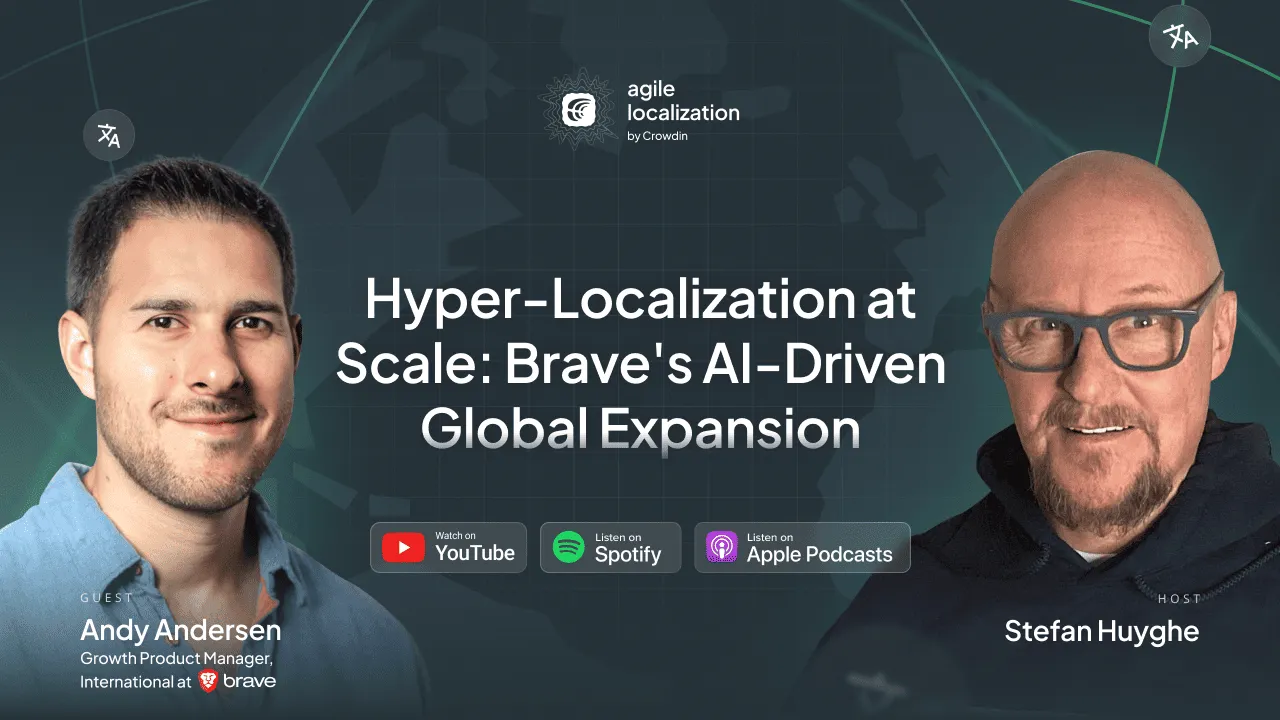When you think of Brave, you probably picture the privacy-first browser taking on Big Tech. But behind the headlines about ad-blocking and crypto-rewards, another kind of innovation is quietly transforming how Brave reaches over 100 million users across more than 50 languages.
That story starts with Andy Andersen, Brave’s Growth Product Manager for International Expansion, who’s redefining what it means to scale global experiences in the age of AI. In his conversation with Stefan Huyghe on The Agile Localization Podcast by Crowdin, Andy shares how his team is weaving AI into localization to supercharge linguists’ impact.
Listen to the new episode on:
Engineering Global Growth
Andy isn’t your typical localization manager. With a decade of experience spanning both LSPs and tech giants like Tinder and Match Group, he approaches localization like a product problem, balancing growth, scalability, and user empathy.
At Brave, his mission is to help millions of users feel at home in the browser, regardless of where they live or what language they speak.
"We have roughly over 50 languages in our product. That scale alone means you can’t just throw more people at the problem. You have to build smarter systems.
To handle that scale, they needed AI.
AI as a Tool, Not a Magic Switch
Andy’s take on AI in localization is refreshingly pragmatic. He laughs at the idea that integrating an LLM is as easy as flipping a switch.
"There’s this tendency to think that you just open up the API key, attach it to your workflow, and let it go. That’s not a good approach. You need guardrails.
At Brave, those guardrails start with content segmentation, carefully deciding which types of content benefit most from automation. Long-form website copy? Perfect for AI-assisted workflows. UI strings and paywall messaging? Still firmly in human hands.
The key is in prompt engineering. Brave builds custom prompts tailored to each content type and language. A JSON file might require a different AI setup than a marketing landing page, and every model is paired with a glossary, tone guidelines, and review process.
This thoughtful structure ensures that AI enhances speed and efficiency without compromising consistency. Otherwise, you’ll spend more money on human review than you save on automation.
Speed Meets Scale
When used strategically, AI accelerates Brave’s localization cycle. What once took a week can now be done in a day or two thanks to human review.
Andy points to Brave’s massive website as a perfect example. Scaling that kind of long-form content manually would not be really cost-effective. Now, with prompt-driven automation and human review, Brave turns around new languages faster than ever before.
Why the Future Belongs to Language Growth Managers
Perhaps Andy’s most interesting innovation isn’t technical at all, but organizational. At Tinder, he built teams of Language Managers who served as bridges between in-market teams, HQ, and external vendors. At Brave, he’s evolved that idea into a new role: the Language Growth Manager (LGM).
Think of an LGM as a mini-CEO for their language. As Andy explains, “My goal is for each Language Growth Manager to think like a growth strategist. They’re not just translating words. They’re asking, How do we grow this product for users who speak my language?”
That shift empowers linguists to analyze app-store performance, test conversion-rate hypotheses, and even propose UX copy changes that drive engagement. It transforms localization from a cost center into a growth engine.
Making Products Feel Native
Beyond speed and structure, Andy’s team is obsessed with hyper-localization, making Brave feel like it was built for each market from the ground up.
That means going beyond literal translation to capture cultural tone, humor, and idiomatic nuance. “If something doesn’t make sense, don’t just translate it word-for-word. You actually want it natively written.”
Hyper-localization also extends to app-store optimization (ASO), where Andy’s team experiments with localized screenshots, keywords, and messaging in order to resonate with each market’s preferences.
Final Thoughts From Andy
For all his enthusiasm about AI, Andy is clear about one thing: the technology is only as powerful as the people behind it.
"AI is not necessarily gonna replace people per se. I think it’s gonna create specialists, people who are able to use the tools and leverage the tools to be much more efficient and highly specific in their training field.
At Brave, those specialists are shaping the future of multilingual communication, combining data, creativity, and empathy to build experiences that feel personal to everyone, everywhere.
And if Andy has his way, the term Language Growth Manager might just become the new gold standard for global teams everywhere.
Andy’s Background
Andy Andersen is the Growth Product Manager of International Expansion at Brave, where he leads localization strategies across more than 50 languages for a user base exceeding 100 million. With over a decade of experience in the localization industry, including significant roles at Tinder and Speechify, Andy specializes in building sustainable international growth programs and scaling localization workflows. He has pioneered innovative approaches to team management, including the development of the Language Growth Manager role, which transforms traditional linguistic positions into strategic growth-focused roles.
Listen to the new episode on:
Yuliia Makarenko
Yuliia Makarenko is a marketing specialist with over a decade of experience, and she’s all about creating content that readers will love. She’s a pro at using her skills in SEO, research, and data analysis to write useful content. When she’s not diving into content creation, you can find her reading a good thriller, practicing some yoga, or simply enjoying playtime with her little one.
